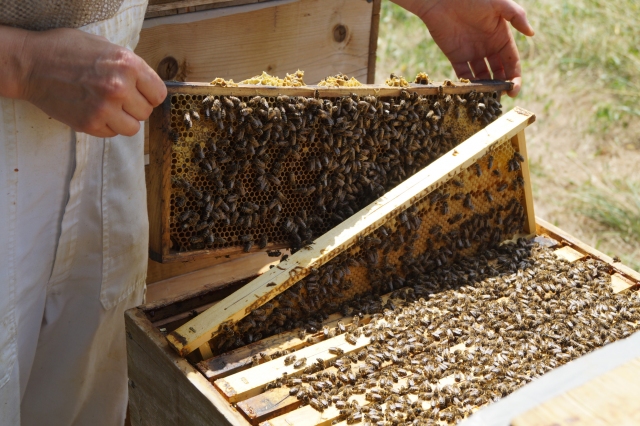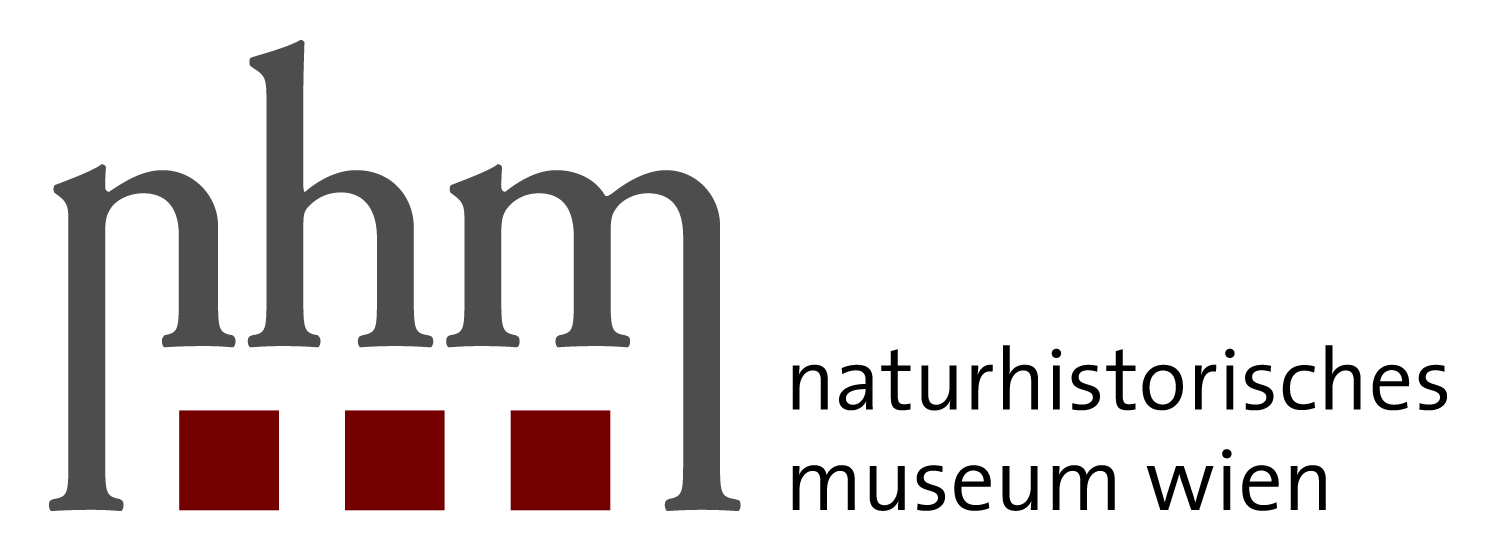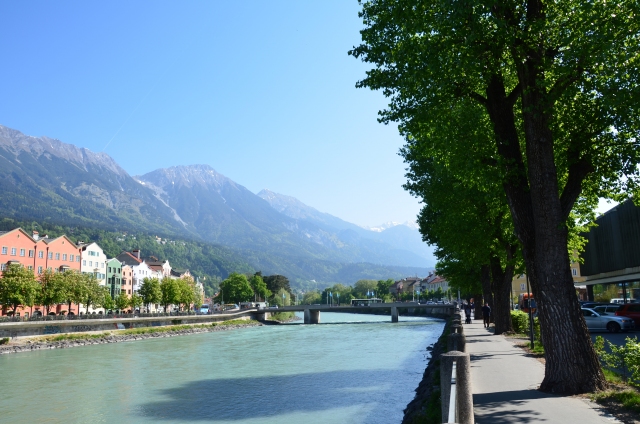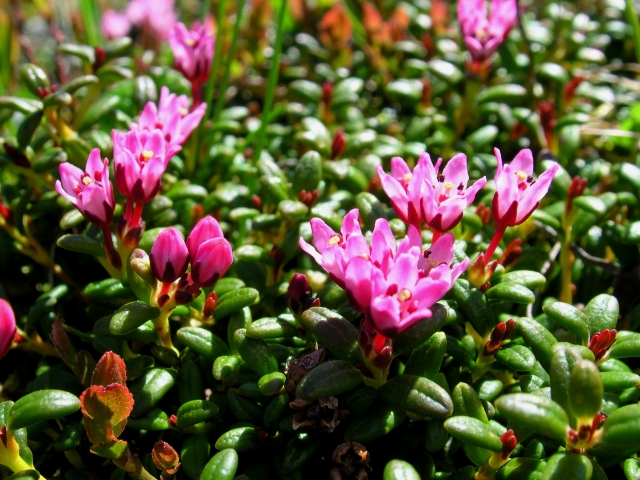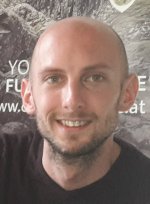
Florian Heigl
Virus monitoring
Which are the most common bee viruses in Austria and are these viruses related to winter losses of local bee colonies? To answer these questions, 200 beekeepers from all over Austria are working as Citizen Scientists in the "virus monitoring" for three years (2018-2020). Each year in September they collect bees from five of their colonies and send them to AGES, Department of Apiculture and Bee Protection. In addition, they report the winter losses of their colonies. The samples are analysed for eight important bee viruses and checked whether the occurrence and severity of the virus infections are related to winter losses. The beekeepers are provided with the virus analyses of their colonies and thus learn more about the health status of their bee colonies.
According to current scientific knowledge, bee viruses, such as the deformed wing virus and the acute bee paralysis virus, are partly responsible for high winter losses. However, other viruses, such as the sacbrood virus or the chronic bee paralysis virus, also cause problems for bee colonies. Unfortunately, we currently only have selective knowledge about the occurrence and frequency of these bee viruses in Austria. Up to now, viruses have usually only been tested, when damage to bee colonies has already occurred. Research results from the USA and neighbouring European countries have shown, that many viruses occur just as frequently in inconspicuously appearing colonies as in clearly damaged ones. In order to make a statement about the frequency of bee viruses, both conspicuous and inconspicuous colonies must therefore be examined (= a representative selection).
"Virus monitoring" is a module of the project "Zukunft Biene 2", which is investigating Austria's bee health from 2017-2021 under the lead of Dr. Robert Brodschneider of the Karl-Franzens-University Graz. Research partners in the project are the University of Graz, AGES and University of Veterinary Medicine Vienna. The project is financed by the Federal Ministry for Sustainability and Tourism (BMNT), the Austrian Federal Provinces, the beekeepers' umbrella organisation "Biene Österreich" as well as in kind contributions of the Karl-Franzens-University Graz, Vetmeduni Vienna and AGES.
Citizen Science Seminar
In 2020, poject coordinator Linde Morawetz held a lecture about "Virus Monitoring" as part of the lecture series "Citizen Science Seminar" at the University of Natural Resources and Life Sciences Vienna (BOKU): "Beekeepers as Citizen Scientists: on the trail of bee viruses" (in German).
Project team
- Citizen Scientists (sample and data collection): 200 beekeepers from all over Austria
- Project management (communication, reporting): Linde Morawetz
- Project implementation (elaboration and preparation of materials): Katharina Etter, Irmgard Derakhshifar, Hemma Köglberger, Rudolf Moosbeckhofer
- Analytics laboratory (method development, analysis): Adi Steinrigl, Sigrid Träger
- Statistician (statistical analysis): Antonia Griesbacher
- Project management overall project "Zukunft Biene 2" (project management): Robert Brodschneider
- Cooperation partners "Zukunft Biene 2" (consulting): Karl Crailsheim, Benjamin Lamp
This project fulfilled version 1.1 of the quality criteria for citizen science projects on Österreich forscht.
Tea Bag Index
Can tea help us understand climate change? Yes, but we need your help! We would like you to become our research partner and take part in one of the largest experiments on soil decomposition processes at the moment!
Herpetofauna
Amphibians and reptiles under observation in Austria
Importance and evaluability of databases increase with the extent, the precision and the currency of the data stored.
The Natural History Museum Vienna, one of the largest non-university research institutions in Austria, houses more than 30 million objects from the fields of biology, earth sciences and human sciences. Since 1982, the Amphibian and Reptile Collection has also been collecting data on the historical and recent distribution of amphibian and reptile species in Austria. All distribution data are documented in the Austrian Herpetofaunistic Database (current data status: about 200,000 records).
When collecting data, the Herpetological Collection also relies on the help of numerous volunteers who make their observations and reports available for inclusion in the database.
Report observations online
Currently Citizen Scientists can use the following platforms to report observations of amphibians and reptiles in Austria:
Please always report your amphibian or reptile observations with a photo (or sound recording in the case of amphibian calls), location and date and please use only one of the websites mentioned.
Report sightings by mail
Herpetological reports of sightings can also be sent by e-mail to This email address is being protected from spambots. You need JavaScript enabled to view it.. If you have large amounts of data on amphibians and reptiles in Austria or would like to ask a question about the project, please contact this address too.
Every reported observation counts! We look forward to your sightings, thank you very much for your support!
Austrian HERPETORACE
Similar to BirdLife Austria’s BirdRace, Citizen Scientists are called once a year in spring to collect as many observations of native amphibians and reptiles as possible within a defined “race time” and, of course, to report them! The event also serves to fill existing mapping gaps, which is why findings are evaluated differently depending on the area. Great prizes are awarded to the winners every year.
The Austrian HERPETORACE 2025 takes place from 31.05. to 01.06.2025 and lasts exactly 48 hours!
Biodiversity Fund project Amphibians and Reptiles of Austria
In 2024 and 2025, the Citizen Science Initiative of the Herpetological Collection will also be supported by the Austrian Biodiversity Fund as part of the “Amphibians and Reptiles of Austria” project.
The Biodiversity Fund project aims to create a broad database on amphibians and reptiles in Austria by compiling, completing and analysing existing data. Habitat loss, diseases, the introduction of alien species and progressive global warming are just some of the factors threatening amphibians and reptiles. A good data basis is crucial and a prerequisite for assessing the conservation status and population trends.
The resulting data pool will form the basis for the compilation of the new Red List, the starting point for a new distribution atlas of Austria's amphibians and reptiles and the basis for the preparation of the report in accordance with Article 17 of the Habitats Directive. And most importantly, all data will be made freely available to everyone via the Global Biodiversity Information Facility (GBIF) and subsequently the Austrian Distribution Atlas.
Roles in the project
- Project management: Coordination of reporters, project coordination and development, public relations, publication activities, database administration, answering enquiries.
- Database administrator: processing and checking the data. Answering enquiries. Public relations, publication activities
- www.herpetofauna.at: Citizen Scientists who provide us with data via their reporting platform, quality control. Publication activities.
- Citizen Scientists: collecting observation data, sometimes publication activities.
Podcast episode
If you would like to learn more, you can listen to the Wissen macht Leute podcast episode about the project (in German). More information can be found here.
Further reading
In October 2021 a great book on the Herpetofauna of the city of Vienna was published:
Schweiger S., Gassner G., Rienesl J. & Wöss G. (Hrsg.): WIEN. Amphibien & Reptilien in der Großstadt.
What is more:
Die Amphibien und Reptilien des Neusiedler See-Gebietes
181 Seiten, 316 Abbildungen
Bestimmungsschlüssel für alle im Gebiet vorkommenden Amphibien- und Reptilienarten
QR-Codes mit Amphibienrufen
Medieninhaber und Herausgeber: © 2015, Verlag des Naturhistorischen
Museums Wien, Burgring 7, 1010 Wien, Österreich, www.nhm-wien.ac.at. Nationalpark
Neusiedler See – Seewinkel Informationszentrum, Hauswiese, 7142 Illmitz, Österreich, https://www.nationalparkneusiedlersee.at
ISBN 978-3-902421-95-1
Citizen Science Seminar
As part of the ‘Citizen Science Seminar’ lecture series at BOKU University, project manager Silke Schweiger gave a lecture on herpetofauna in 2025 entitled ‘Amphibians and Reptiles of Austria Under Observation: Thirty-five Years of Long-Term Monitoring with the Support of Citizen Scientists'.
This project fulfils version 1.1 of the quality criteria for citizen science projects on Österreich forscht.
German in Austria (IamDiÖ)
Project description
When it comes to language, everyone can have a say!
"IamDiÖ – German in Austria" invites you to explore the diversity, change and use of all possible forms of German in Austria, from dialect and standard language to youth language and jargon.
By including the knowledge, opinions, experiences and concerns of the citizens in the research process, socially relevant topics are addressed and discussed publicly.
The aim of the Citizen Science project "IamDiÖ – German in Austria" is to encourage everyone to engage with their (own) use and perception of the German language in Austria and to conduct research in this field. In this way, exchange between the interested public and academia is facilitated and academia becomes tangible through citizen science. Academia, in turn, can gain new insights and approaches through public participation.
There are many ways to contribute to the projekct, addressing different aspects of the German language in Austria.
The questions in the project are:
- Which words are used in Austria?
- Which topics are of interest to the Austrian population when it comes to German in Austria?
- How can citizens use their knowledge, concerns and experience to contribute to research into the German language in Austria?
How can one participate?
There are various ways to take part in "IamDiÖ – German in Austria".
1. Collecting words
Speakers of the German language in Austria collaboratively create a digital dictionary by entering words they use or hear on the “Wortgut” website. This allows to collect a large number of words used in Austria – some of which may have never been written down before. All forms (varieties) of the German language in Austria can be entered in the dictionary, ranging from standard language and dialect to youth language and jargon. If you use this word in Austria, it is a perfect contribution to our collection.
2. Question of the month
You can submit questions about the topic of "German in Austria" (Question of the month). The question of the month provides an insight into socially relevant topics on the German language in Austria. If there is already an academically sound answer to this question, scholars from "German in Austria" will provide an answer. If there is not an answer yet, you can search for an answer yourselfand start your own research project. In this way, citizens themselves become researchers in the field of linguistics. The website of the project provides information, instructions, methods and tips on the research process so that participants can find an answer to their questions.
Once a month, two of the questions submitted or researched are selected and participants can vote on the Facebook project page to decide which of the two questions should be answered this month. The question with the most votes will be answered either by you or our scholars on the project website.
3. Search for written text in the public space
Everyone can search for writing in public space. Among the research objects are posters, signs, stickers on the street, in the park or in public buildings, which contain written text in a language or in a language variety (e. g. dialect). Participants can take photos of these posters or signs (with the Lingscape App) and provide additional information (e. g. geoinformation or which languages can be seen). These photos are used, among others, to analyse the variety and dynamics of written text in the public sphere. They can be viewed and analysed by users on a map in the app or on the Lingscape website.
The photos of written text in public space can easily be taken on the way to work or school.
However, there are also organised scavenger hunts to collect and analyse images as a group (current scavenger hunt dates).
4. Meme Competition
In the meme competition, dialect memes can be created in a meme generator. The aim is to investigate the creation and distribution of memes in online media in connection with language use from a communication science perspective. Participants can add language, e. g. dialect, to pictures.
What happens to the contributions?
The words collected in the digital dictionary “Wortgut” can be accessed by the public. They are used as basis for answering research questions in different fields, such as: Which words are used in certain regions? How to write dialect? Which expressions are part of youth language or jargon?
The Questions of the Month and all results are presented on various channels such as the website and social media as well as on the research platform "German in Austria. Variation – Contact - Perception".
The pictures of the scavenger hunt for written text in public spaces will be stored and archived by the project partner Lingscape.
The memes are used for academic analyses in the field of communication.
What do I gain if I join in?
Participants gain an insight into linguistic research and can (ideally) carry out research themselves with the help of academics. They are encouraged to reflect on their use of language and their own perception of it. Awareness of language use and its perception is created.
Supported by:

Wissenschaftsfonds (Austrian Science Fund: FWF TCS 40 and FWF TCS 57-G)
This project fulfilled version 1.1 of the quality criteria for citizen science projects on Österreich forscht.
Citree
With the Citizen Science Project "CITREE" a crowdsourcing instrument for monitoring the growth of urban trees, will be developed and used. It builds on the "Sparkling Science" project "Woody Woodpecker", which deals with the growth, structure and function of wood.
Urban trees fulfill a variety of functions, such as improving the microclimate and air, noise protection or the design of public spaces. Monitoring of urban trees is important because climate change leads to an intensification of stress on the trees. In cities, trees are exposed to extreme heat and drought and are additionally affected by other stress factors such as pollutant emissions, limited root space, salt stress or pest infestation. Therefore, trees in cities are "living laboratories" that allow analyses of stress mechanisms and estimates of future developments. CITREE is intended to provide a tool for monitoring urban trees and thus create a bridge between citizens and their trees: On the one hand citizens can participate in the monitoring process, on the other hand they can see and learn how their trees grow. This feedback will also be used to present the work of public institutions (e.g. city nurseries) and will enable school projects on urban trees and urban ecology. Three schools in Vienna and Innsbruck are currently involved in researching as part of the Stadt-Baum-Boden project.
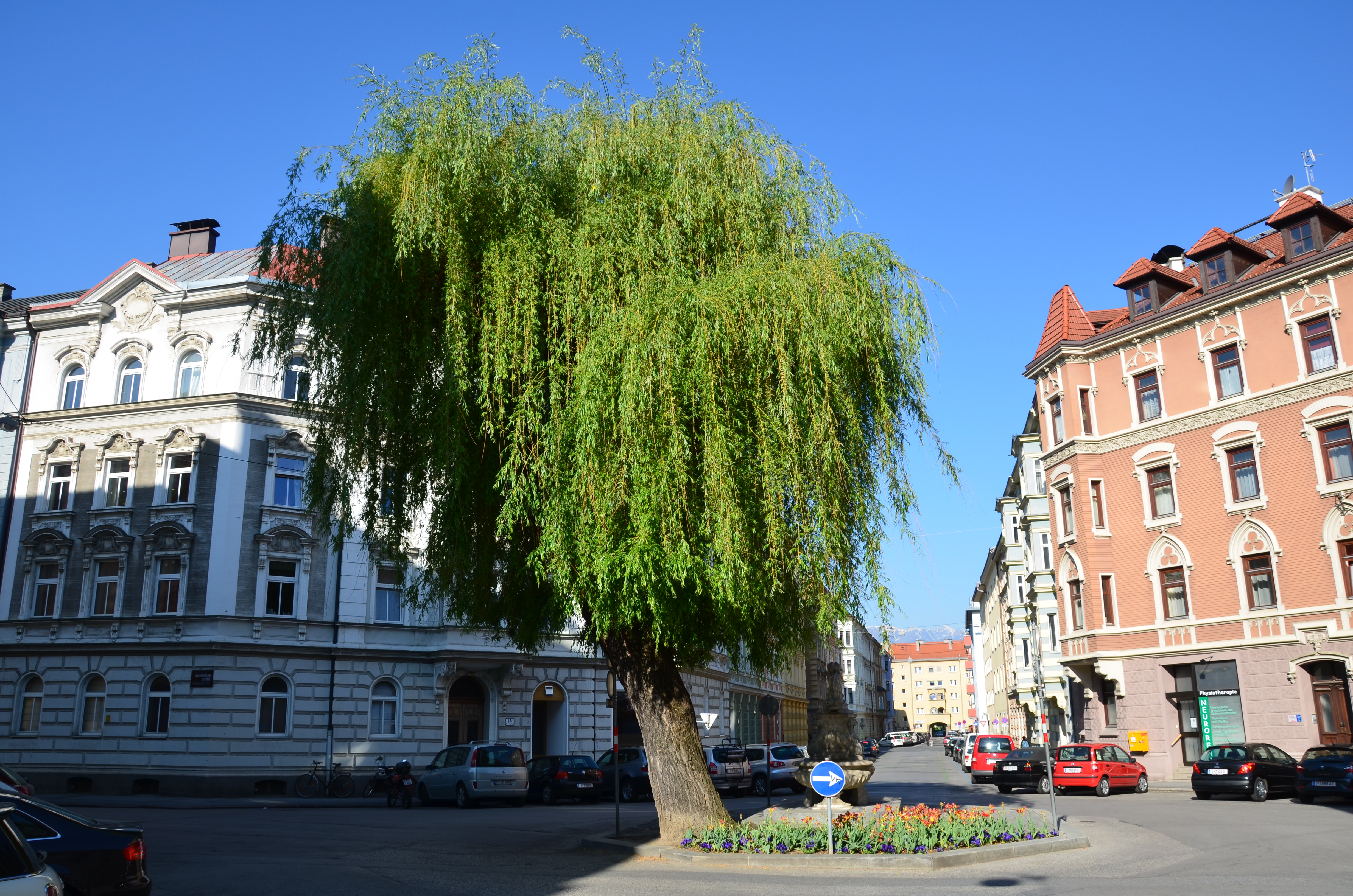
(c) CITREE
CITREE is based on easy to install and cheap band-dendrometers, with which the trunk circumference and thus the growth can be measured. Dendrometers installed on urban trees are read by citizens who have access to the CITREE database via QR code and smartphone. The CITREE database collects the growth data of all trees and makes it available to involved citizens, the public, public institutions and researchers.

The main work packages of the project are:
- Selection/modification of suitable dendrometers
- Development of an installation system
- Development of the CITREE database
- Test and optimization of the developed systems under urban conditions
- Data analysis and
- Installation of the systems in Austrian cities.
The project will be carried out at the Institute of Botany, University of Innsbruck and will benefit from the long experience in the field of science communication of the PI (Stefan Mayr) and his staff. The development of the CITREE database is carried out in cooperation with the University of Ghent and the company Phyto-IT, Belgium. A cooperation with the School of Education, University of Innsbruck serves the didactical optimization. For the installation in Austrian cities, city nurseries and researchers will be contacted to collect a first broader data set on the growth of urban trees. In the long term, CITREE is to be further developed into CITREE-EU, thus enabling a monitoring network in European cities.
Tasks and roles in the project:
- Citizen Scientists:enter the numbers read from the dendrometer and receive a graphical display of the calculated tree diameter including the previous history.
- Research assistants: handle special cases (resetting dendrometer, removing obvious mismeasurements...), tracking patterns of growth, vandalism, etc.
- IT-assistant: Creating new trees in the database and on the homepage
If you have any questions about the project, or are interested in participating in the project, please write to This email address is being protected from spambots. You need JavaScript enabled to view it..
This project fulfils version 1.1 of the quality criteria for citizen science projects on Österreich forscht.
Categories to come
What is the project specifically about?
So much hangs on just one thing - and yet words sometimes fail us. How do we talk about our bodies and the things that we need, want, and do when it comes to sex and sexual pleasure? And who do we talk to about these things? Categories to Come invites everybody to put their sexuality into words, and to discuss new words or new uses of words with other people. Goal of the project is to create a platform and gather resources, that open up so far unnamed subject areas of sexuality. They will be accessible both for personal gain and interdisciplinary research.
How can citizens participate in research?
Citizens are actively involved in shaping the future vocabulary of sexual language and provide important impulses for research. Citizens can write down their own terms and descriptions for intimate activities and their own sexual desire. They can also collect and name passages from songs, books or films that are sexually interesting to them. They can look at films and photos and other cultural works and describe what can be seen there and index them. They can read books and texts and filter out places with sexual acts and tag them.
What happens to the results?
The results form a resource to illustrate previously unnamed areas of sexuality. This data collection will be organized and made available as a database and can be used to enhance studies by researchers working in linguistics, social sciences, sexology, gender studies and literature as well as for art production.
What does the research contribute to?
Categories to come helps to build a new resource for research on sexuality in different disciplines. The project is based on two assumptions, namely, 1) the existing sexual vocabulary has only been partly described, and 2) because of sexuality’s visual nature, lack of language, and location within the realm of experience, there are many fantasies and sex acts that nobody has yet attempted to put into words. The project Categories to Come combines artistic and academic research interests. In contrast to purely scientific research, the artistic element also allows one to become creative and to create new words. Categories to come thus contributes to making research into sexual language and sexual desire more diverse.
This project shows what the artistic aspect can be in a research context, how it produces a different kind of knowledge than purely scientific research and how this can make a contribution in an interdisciplinary context. By making the results publicly accessible, citizens can use the database themselves and find new ways and terms to talk about sexuality. This counteracts tabooing and promotes a conscious discussion of one's own sexuality.
Image gallery
-
 "so much revolves around this one topic" "so much revolves around this one topic"
"so much revolves around this one topic" "so much revolves around this one topic" -
 "and still we sometimes miss words" "and still we sometimes miss words"
"and still we sometimes miss words" "and still we sometimes miss words" -
 Facebook header of the project Facebook header of the project
Facebook header of the project Facebook header of the project
https://www.citizen-science.at/en/projects/how-to-list-a-project/author/934-florianheigl?start=150#sigProId8680991c3e
This project fulfilled version 1.1 of the quality criteria for citizen science projects on Österreich forscht.
Nature conservation monitoring
We take care of our meadows and alpine pastures!
For more than a decade, hundreds of farmers have been saying "We look at our meadows and alpine pastures!".
The regular observations of the more than 700 participants impressively show that on more than 80 % of the monitoring plots in extensive grassland the number of individuals of the species observed has remained the same or even increased.
By observing the animals and plants every year, the perspective with which the farmers perceive their meadow changes and a process of more conscious action is set in motion.
Background
In monitoring extensive grassland, participants look at which management practices promote or inhibit the occurrence of individual plant and animal species.
The Austria-wide observations of plant and animal diversity provide new insights into the benefits of management in extensive grassland. (By extensive grassland we mean species-rich meadows that are mowed a maximum of two to three times a year or not at all or only slightly fertilized and gentle grazing.)
The species-rich grassland has been displaced by a frightening 90% since the 1960s due to structural changes in agriculture and land use change! The last occurrences of colorful flower meadows are therefore landscapes with a high number of species and important retreat areas for plant and animal diversity in Austria!
By regularly observing the development of indicator species, the meaning of different agri-environmental measures (ÖPUL) such as contractual nature conservation, organic farming (BIO) and environmentally friendly and biodiversity-promoting management (UBB) is made understandable and it is observed at farm level whether agricultural subsidies also have an effect on the area.
The nature conservation monitoring will show which type of management is well suited for the type of meadow under consideration and therefore leads to safe stocks of the observed indicator species. As a result, management requirements can be better evaluated on the basis of feedback from farmers and funding can be awarded in a targeted manner.
Participate
All farmers with (potentially) extensive meadows and pastures who take part in the agri-environmental measure ÖPUL “Organic farming (BIO)” or “Environmentally friendly and biodiversity-promoting management (UBB)” can take part. At the beginning there is an enrollment by an ecologist. It is agreed which indicator species are to be observed and counted annually. The participants then document the indicator species and the management of the meadow every year and enter the data on the online platform www.naturschutzmonitoring.at.
Project duration: until 2029
Information on participation:
- Hotline: +43 677 643 130 71
- Mail: This email address is being protected from spambots. You need JavaScript enabled to view it.
Quotations of participants
„This year I deliberately left a patch of rambling bellflowers so that they could sow seeds. Now I am already curious whether they will be more next year!“
„This project is going places. My son wanted to reforest our rough pasture some time ago, because the fodder is worth nothing and mowing takes a lot of time. Since your expert showed him that there are a lot of rare animals and plants living in it, he hasn't said anything about it. He even helps me counting now.“
„What makes me particularly happy is that for once it is not about control or money, but about seeing and appreciating the beautiful aspects of our work.“
You can also follow the ÖKL on Facebook, Instagram and YouTube for further information.
Project management
Barbara Steurer
Österreichisches Kuratorium für Landtechnik und Landentwicklung (ÖKL)
Gußhausstraße 6
1040 Wien, Austria
www.oekl.at
https://www.citizen-science.at/en/projects/how-to-list-a-project/author/934-florianheigl?start=150#sigProIddb6afa55fd
This project fulfils version 1.1 of the quality criteria for citizen science projects on Österreich forscht.
BeeRadar
We are tracing the Sculptured Resin Bee!
Home of the Sculptured Resin Bee (Megachile sculpturalis, Smith 1853) is far away in Japan, China, Korea and Taiwan. In 2008, the Sculptured Resin Bee was discovered in southern France as the first introduced wild bee species in Europe. Since then, the bee has been particularly active and dispersed rapidly throughout Europe. Together, we track down the Sculptured Resin Bee in Austria.
Report your observations via email at This email address is being protected from spambots. You need JavaScript enabled to view it. or on Instagram.

You can also scan this QR-Code to go directly to the website:
The look of the Asian bee is remarkable
The sculptured resin bee has a unique appearance:

© Felix Fornoff 2020
Where you can find the Sculptured Resin Bee
The sculptured resin bee nests in cavities in dead wood. They often inhabit artificial nesting sites, so-called "bee hotels". There, the females build nests and take care of their offspring. Such aids are necessary since it cannot drill holes in the wood on its own, even though the body size and powerful jaws might lead you to believe otherwise.
https://www.citizen-science.at/en/projects/how-to-list-a-project/author/934-florianheigl?start=150#sigProIddb4e59b282
Females prefer to collect pollen from exotic plants, which were frequently introduced in Central Europe as ornamental trees and shrubs. These ornamental plants decorate gardens and parks, such as the Japanese pagoda tree (Styphnolobium japonicum). As source of nectar, the sculptured resin bee often seeks out lavender or wisteria. Males of the Sculptured Resin Bee emerge earlier than females in the End of June until mid-July. Females appear a few weeks later and are active until about mid-September.
https://www.citizen-science.at/en/projects/how-to-list-a-project/author/934-florianheigl?start=150#sigProIdbf4d44bd56
Introduced is not invasive
The sculptured resin bee is the first and so far, only invasive wild bee in Europe.
Citizen Scientists of this particular project provided important insights into the competitive behavior against native bees. Participants reported observations where females of the sculptured resin bee were evacuating preoccupied nests of native bees. Once they cleared out larvae and pupae, these females used the nests for their own offspring. Based on these observations combined with a recent study from France, the sculptured resin bee has to be considered as an invasive species.
Not every introduced species is per se a severe threat for native biodiversity. Every new species needs to be monitored closely in terms of potential consequences for its new environment. But if negative impacts are observable, the species must be considered as invasive.
Project aims
The monitoring program aims to locate the sculptured resin bee in Europe. We examine its rapid dispersal behavior, investigate its preferences in regard to plant and nesting site selection and to reconstruct its colonization history.
Additionally, we take a closer look at the genetics of the sculptured resin bee. With these lab studies we examine the bee’s immigration history. Based on our international network of experts, we aim answer various research questions like which microbiota colonizes the bee.
For more information, please watch our short clip:
This project also aims to sensitize the participants to the local fauna and get aware of wild bees and their protection. The citizen scientists get a feeling for the possible effects of intentionally and unintentionally introduced and invasive species. A new point of view is presented to the participants in regard to artificial nests and active interventions in ecological systems. Participants will be informed how simple actions can be taken to support wild bees and other insects. They will also become part of scientific processes and gain insight into research processes.
Our published results
Within the last few years, we studied the invasive bee together with our participants. We published the results in scientific articles by choosing Open Access Journals.
2020
The first results of the initiated citizen science monitoring program were published in 2020. Within only two years after starting the project, 111 new reports from Switzerland, Liechtenstein and Austria were recorded. The population progressed remarkably fast from year to year expanding its region geographically, but also ecologically. The distribution pattern indicates that Austria is situated in a rather young invasion stage so far. The article can be found here.
2021
We performed population genetic analyses including specimens collected in the framework of a citizen science project. The aim was to study the colonization history and investigate the degree of connectivity between bees across Europe. We detected multiple, independent introduction events of the species to the European continent. This article can be found here.
For us, it was a special pleasure to publish an article describing the distribution of the invasive bee in Austria together with a Citizen Scientist. For the journal „Beiträge zur Entomofaunistik“ we introduced the sculptured resin bee as a new bee species for Austria. To read this article, you can click here (German).
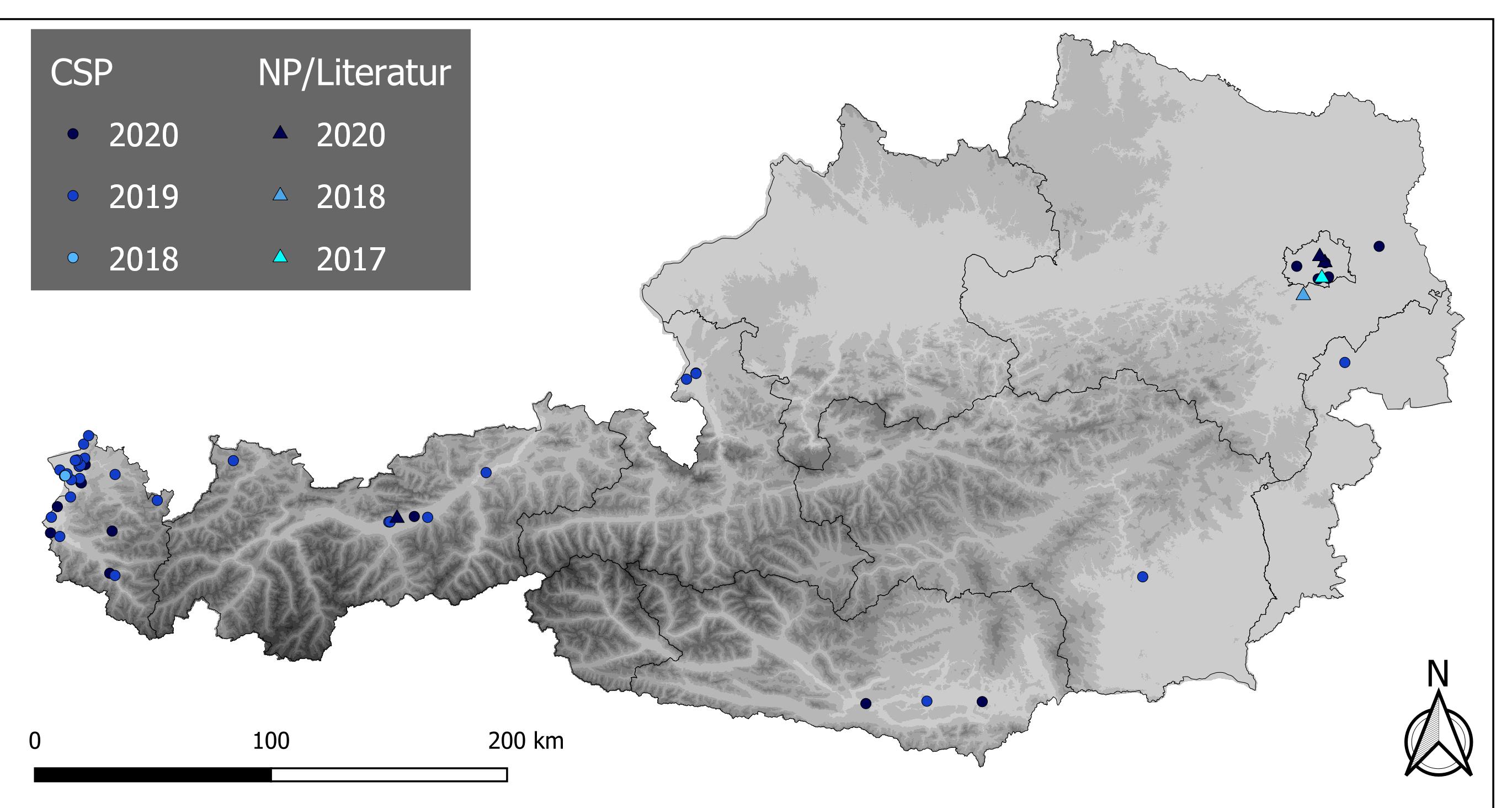 Spread of M. sculpturalis in Austria (2017-2020) © Lanner & Meyer 2020
Spread of M. sculpturalis in Austria (2017-2020) © Lanner & Meyer 2020
In a review published in the journal BeeWorld, we describe the main characteristics of the sculptured resin bee, its life cycle and its current distribution in colonised regions. We discuss possible ecological impacts on native bees. We also explore the role of beekeepers in monitoring projects and argue why they are valuable participants in citizen science projects.
The review is accessible here.
2022
BeeRadar launched an international study consisting of 19 authors from all over the world: USA, China, France, Italy, Serbia, and Austria. Using complex model calculations (species distribution modelling), we identified regions that are colonised by the sculptured resin bee, and influencing factors for its spread. Most of the data was collected with the support of the public. Man-made landscape structures, such as road networks, settlements and ports and airports, facilitate the spread of the Sculptured Resin bee. Click here for the article.

Even though citizen science has its momentum in many western regions, it is a less explored research practice in Eastern Europe. Together with our colleagues from the University of Belgrade, we initiated a first ecological-focused citizen science project in Serbia. We present the currently known distribution of the sculptured resin bee in the Balkans and discuss the potential and challenges of participatory research and intercultural science communication in Eastern Europe.

Podcast episode
Project leader Julia Lanner was a guest on an episode of the Österreich forscht podcast "Wissen macht Leute" in August 2022 - anyone interested in learning more about the project can listen to the episode here (in German).
Citizen Science Seminar
In 2021, poject coordinator Julia Lanner held a lecture about BeeRadar as part of the lecture series "Citizen Science Seminar" at the University of Natural Resources and Life Sciences Vienna (BOKU): "The making of 'Wanted - Asiatische Mörtelbiene'" (in German). At the end of this page you can watch the video recording of the lecture.
Project partners
- Inatura Erlebnis Naturschau GmbH
- Entomologische Verein Bern
- Naturschutzbund Österreich
- Naturbeobachtung.at
- Pollinature Beehome
This project fulfils version 1.1 of the quality criteria for citizen science projects on Österreich forscht.
Vielfalt bewegt! Alpenverein from young to old
This project of the Austrian Alpine Association - a biodiversity monitoring above the timberline - increases our knowledge about alpine animal and plant species, their habitats and about the interrelationships of our actions and the effects on this sensitive living environment. The collected data on the 20 animal and plant species contribute to scientific questions on biodiversity in the Alps.
Message
Which animals live and which plants grow in our mountains? Within the framework of "Vielfalt bewegt! Alpenverein from young to old" the Austrian Alpine Club investigates the most elevated habitats in Austria - a project for mountain enthusiasts and everyone who wants to become one!
This project overseen by the Austrian Alpine Club is planned as a long-term study and should contribute to the preservation and promotion of biological diversity in the Alps. Biodiversity monitoring in the highest habitats in Austria is intended to inspire people with an affinity for the mountains.
Like all citizen science projects, this project also depends on its voluntary helpers, who observe typical animal and plant species of the Alpine region over a longer period of time and condense and pass on their knowledge about the Alpine habitat.
Aims of the project
The purpose of monitoring is to develop appropriate measures on the basis of the knowledge gathered, which can reduce the decline of species and secure or improve habitats for endangered species in the long term. The consequences of climate change (migration of some species to higher regions or changes in food resources) can also be demonstrated in this way. On the one hand, distribution maps are to be generated to provide information on the occurrence of the individual species and, on the other hand, the data are to be made available for publications etc. on request.
The project offers mountaineers the opportunity to experience nature consciously and attentively again in contrast to summit attempt and pressure to perform.
The project "Vielfalt bewegt! Alpenverein from young to old" provides knowledge about alpine species and the connections to the conservation of biological diversity in alpine habitats in an age-appropriate form for children, youths, parents and grandparents. The pillar for the long-term continuation of the project idea is the intergenerational exchange about nature, its habitats and species. Parents and grandparents become multipliers. In the course of this, cooperation with "Alpenvereinsjugend", which has been active in education for sustainable development for a long time, is also strengthened.
-
 Alpine salamander Alpine salamander
Alpine salamander Alpine salamander -
 Small Apollo Small Apollo
Small Apollo Small Apollo -
 Mountain Arnica (Wolf's bane) Mountain Arnica (Wolf's bane)
Mountain Arnica (Wolf's bane) Mountain Arnica (Wolf's bane) -
 Alpine chough Alpine chough
Alpine chough Alpine chough -
 Mountain avens Mountain avens
Mountain avens Mountain avens -
 Identifying species Identifying species
Identifying species Identifying species -
 Alpine Azalea Alpine Azalea
Alpine Azalea Alpine Azalea -
 Identifying species II Identifying species II
Identifying species II Identifying species II -
 Identifying species III Identifying species III
Identifying species III Identifying species III -
 Spotted Nutcracker Spotted Nutcracker
Spotted Nutcracker Spotted Nutcracker
https://www.citizen-science.at/en/projects/how-to-list-a-project/author/934-florianheigl?start=150#sigProId5891ec5508
Procedure
Different indicator species, which have their habitat above the forest line, were selected on the basis of various criteria - including alpine ptarmigan, mountain avens, oak spider or mountain azalea.
Observations are made at any time and on any hike, as the whim takes you!
Compact identification guides for the selected plants and animals should make it easier for the observers to track down the species during their hikes. Exciting and informative stories serve as a reminder. Data from nature observation, such as geographical location, altitude, weather or a description of the habitat of the indicator species, can then be entered in clearly structured questionnaires. As a matter of principle, observations are only made along existing hiking trails in order to conserve flora and fauna.
To make monitoring a little easier, a handy mapping guide was designed that can easily be taken into the field in addition to the 20 revised identification guides. In the mapping guide, the monitoring is briefly introduced again and it is explained where, how and when the 20 species sought can best and most easily be found. Selected identification sheets as well as the mapping instructions can be downloaded at the bottom of this page. A continuously updated distribution map can be seen here. The nature diary presents 20 animal and plant species that are typical for the Alpine region and also describes many helpful tips and tricks for observing them.
To record the observations, you can either use the web portal "Diversity moves, Alpine Association" or the app of the project. You can take photos directly with your smartphone; your location is automatically determined by the GPS transmitter. This way, if the internet connection is up and running, the observation can be transmitted directly to the web portal. If there is no reception, the data is saved locally in the app and sent to the web portal as soon as a connection can be found again.
How can you participate?
To take part in "Diversity moves! Alpine Club from Young to Old", you can register for the project via the registration form on the website. As soon as the registration is completed, you will receive a confirmation from the project team and can get started right away.
Memo Game
Within the project "Diversity moves! Alpine Club from Young to Old" (Biodiversity Monitoring), a beautiful memo game with 32 pairs of cards has been created. The drawn illustrations show different alpine animal and plant species that have their habitat above the timberline. In the enclosed booklet, in addition to the game instructions, all species are explained and their special characteristics highlighted. Sustainably packaged in a handy cotton bag, the game takes up hardly any space.
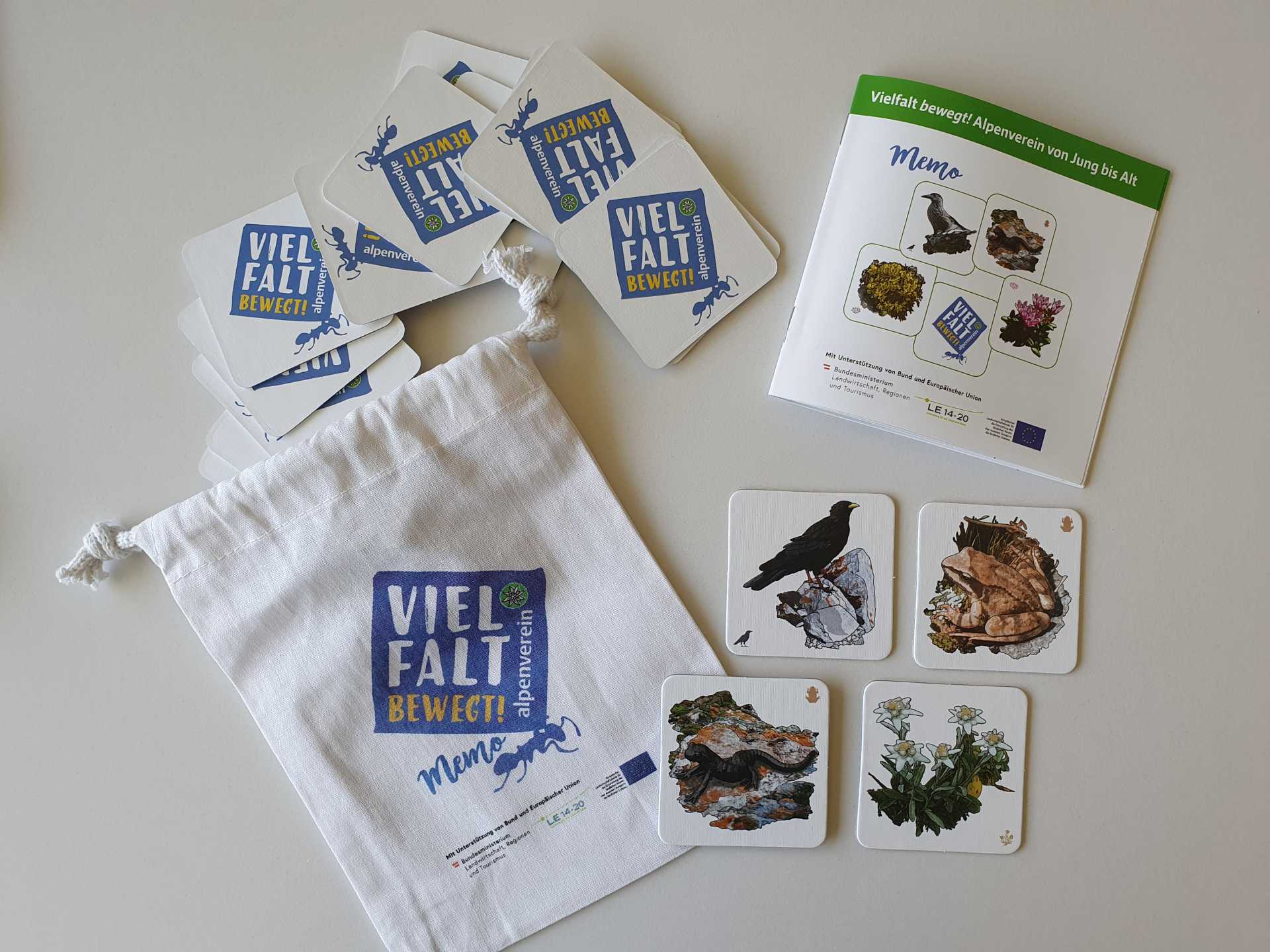
© Birgit Kantner
With the support of the federal government and the European Union within the framework of the implementation of the Austrian Programme for Rural Development 2014-2020.
This project fulfilled version 1.1 of the quality criteria for citizen science projects on Österreich forscht.
Butterflies of Austria
App for the scientific recording of Austrian butterflies
On behalf of Blühendes Österreich - BILLA gemeinnützige Privatstiftunga, butterfly expert Peter Huemer published a report on the dramatic state of the butterfly fauna in May 2016. In Europe, their number had fallen by half since 1990 and over 50 percent of Austria’s butterflies are acutely threatened with extinction according to the Red Lists. Butterfly habitats have been massively restricted by agricultural intensification, increasing urban sprawl and the drastic loss of species-rich flower meadows in general, and their disappearance, which has received little public attaention to this date, ist described by experts as a clear indication of the imbalance in the entire ecosystem.
Every photo counts
The foundation Blühendes Österreich and the Lower Austrian environmental movement “Natur im Garten" are calling for Austria's first butterfly census with the "Schmetterlinge Österreichs" app.
Whether garden owner or park visitor, farmer, mountain lover or hiker or simply nature lover and butterfly fan - every Austrian can make a contribution to recording the population of Austrian butterflies as a citizen scientist: The app contains around 160 identifiable butterfly species and 32 moths and enables butterfly observations to be reported with just a few clicks and without complicated technical applications. Using an integrated photo function, photos are uploaded to a gallery within seconds and made available to the community and researchers.
Austrian butterfly gallery
Users contribute to the largest Austrian butterfly gallery with their sightings and photos. In less than a second after creating a photo and a sighting report, the data is put online in a gallery and can be shared and discussed with the butterfly community. The gallery is visible in a desktop version as well as on a smartphone. The passion, performance and commitment of each user is made visible and their reports are scientifically evaluated. Making the work of users visible is a major concern for Blühendes Österreich and “Natur im Garten”.
Identification forum
All butterfly lovers are invited to help users of the app with questions about identification or sightings. Blühendes Österreich and "Natur im Garten" seek to establish a lively and communicative butterfly forum with Austrian butterfly lovers. With the smartphone as a constant companion, the direct and simple connection to the community is given.
Citizen Science
By using the app and reporting sightings, each individual user contributes to the valuable recording of Austrian butterfly populations. Blühendes Österreich publishes the sightings as well as an annual evaluation (in cooperation with "Natur im Garten").
The proven experts Dr. Helmut Höttinger, Dr. Peter Huemer and DI Thomas Holzer have been recruited to provide scientific support and advice. Dr. Huemer is also on the board of the Blooming Austria Foundation.
Podcast episode (only available in German)
In November 2022, project coordinator Ines Lemberger was a guest on the Österreich forscht podcast "Wissen macht Leute" and provided many exciting insights into the project - you can listen to the episode here.
Citizen Science Seminar (only available in German)
Ronald Würflinger, secretary general of Blühendes Österreich, gave a lecture on "Austria's Butterflies" as part of the "Citizen Science Seminar" lecture series at BOKU University in 2022: "Of Power of Community, Butterflies and Open Data".
Austria's Butterflies on Social Media
Videos (only available in German)
Zeig her deinen Schmetterlingsgarten
2. Runde: Zeig' her deinen Schmetterlingsgarten 2018
Ausgeflattert II - im Burgenland, Niederösterreich, der Steiermark und in Wien
Ausgeflattert III - in Kärnten, Oberösterreich, Salzburg, Tirol und Vorarlberg
-
 Scarce swallowtail (Iphiclides podalirius) Scarce swallowtail (Iphiclides podalirius)
Scarce swallowtail (Iphiclides podalirius) Scarce swallowtail (Iphiclides podalirius) -
 Painted lady (Vanessa cardui) Painted lady (Vanessa cardui)
Painted lady (Vanessa cardui) Painted lady (Vanessa cardui) -
 Red admiral (Vanessa atalanta) Red admiral (Vanessa atalanta)
Red admiral (Vanessa atalanta) Red admiral (Vanessa atalanta) -
 Meadow brown (Maniola jurtina) Meadow brown (Maniola jurtina)
Meadow brown (Maniola jurtina) Meadow brown (Maniola jurtina) -
 European peacock European peacock
European peacock European peacock -
 Small white Small white
Small white Small white -
 Marbled white (Melanargia galathea) Marbled white (Melanargia galathea)
Marbled white (Melanargia galathea) Marbled white (Melanargia galathea) -
 Common brimstone (Gonepteryx rhamni) Common brimstone (Gonepteryx rhamni)
Common brimstone (Gonepteryx rhamni) Common brimstone (Gonepteryx rhamni) -
 Common blue butterfly (Polyommatus icarus) Common blue butterfly (Polyommatus icarus)
Common blue butterfly (Polyommatus icarus) Common blue butterfly (Polyommatus icarus) -
 Silver-washed fritillary (Argynnis paphia) Silver-washed fritillary (Argynnis paphia)
Silver-washed fritillary (Argynnis paphia) Silver-washed fritillary (Argynnis paphia) -
 Hipparchia hermione Hipparchia hermione
Hipparchia hermione Hipparchia hermione
https://www.citizen-science.at/en/projects/how-to-list-a-project/author/934-florianheigl?start=150#sigProIde7d646aceb
This project fulfils version 1.1 of the quality criteria for citizen science projects on Österreich forscht.

